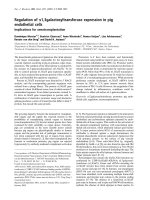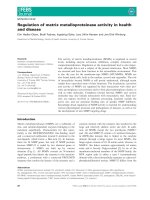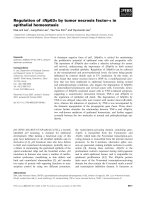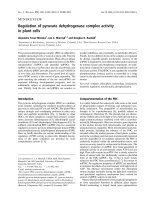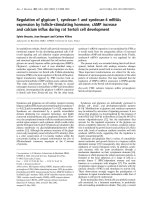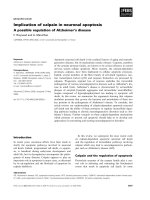Báo cáo sinh học: "Regulation of metabolism in Caenorhabditis elegans longevity" ppsx
Bạn đang xem bản rút gọn của tài liệu. Xem và tải ngay bản đầy đủ của tài liệu tại đây (218.12 KB, 3 trang )
Aging in Caenorhabditis elegans seems to be intimately
tied to the modulation of metabolism. e first genes
identified for their ability to affect life span were age-1,
which encodes a phosphatidylinositol kinase [1], and
daf-2 (constitutive dauer formation), which encodes a
receptor tyrosine kinase similar to the mammalian
insulin and insulin-like growth factor 1 (IGF1) receptors
[2]. Although complete loss of daf-2 function is lethal [3],
partial loss of function extends adult life by two- to
threefold. daf-2 and age-1 specify steps in the insulin/
insulin-like signaling (IIS) pathway, thereby influencing
metabolism. IIS signaling inactivates the FOXO (forkhead
box O) transcription factor DAF-16, which controls
genes that mediate a wide variety of functions, including
metabolism, innate immunity, stress response, and
translation (reviewed in [4]). e modulation of life span
by the IIS pathway seems to result from an intricate
network of physiological changes primarily mediated by
unregulated DAF-16 activity, including major shifts in
both energy and fat metabolism.
In addition to the IIS pathway, two other main groups
of genes have profound effects on life span and are linked
to metabolic control: genes involved in dietary restriction
and mitochondrial function. Dietary restriction has been
associated with increased life span in a wide variety of
species (including mammals) and appears to be univer-
sally associated with longevity (reviewed in [5]). Increased
longevity resulting from mutations in genes that regulate
mitochondrial function is more proble matic, although, at
least superficially, it is related to metabolic slow-down.
Work in nematodes and other invertebrates seems to
support the notion that reducing the rate of oxidative
phosphorylation (OXPHOS) leads to increased life span
in two major ways: by decreasing the metabolic rate, and
by reducing the level of reactive oxygen species, which
are an obligate byproduct of OXPHOS. However, muta-
tions that reduce mitochondrial function are beneficial
for C. elegans longevity, but have deleterious and often
lethal effects in mammals [6]. e reason for this discre-
pancy is not understood.
Given the large number of genes that have been shown
to regulate life span through different pathways, it is
reasonable to ask whether there are any physiological
changes conducive to longevity that are common in all
long-lived mutants. A recent metabolomic study on five
different long-lived mutants published in BMC Biology by
Fuchs et al. [7] suggests that the answer to this question
may be yes. Fuchs et al. report that mutants carrying
three different alleles of daf-2, one allele of the insulin-
like gene daf-28 or one allele of ife-2 (translational initia-
tion factor 4E) have similar metabolic signatures, which
cluster away from those of wild-type worms. ese meta-
bolic signatures are consistent with previous findings that
assessed gene expression in daf-2 mutants [8]. In par ticu-
lar, they showed that long-lived daf-2 worms upregulate
the glyoxylate cycle, gluconeogenesis and starch
metabo lism.
Fuchs et al. [7] detected a common metabolic signature
for IIS mutants and ief-2. All five of the long-lived
mutants had increased pools of amino acids, especially of
the branched-chain amino acids isoleucine, leucine and
valine, together with phenylalanine and tyrosine. A
similar increase in branched-chain amino acids has been
found in animals carrying mutations in components of
Abstract
The nematode Caenorhabditis elegans is a favorite
model for the study of aging. A wealth of genetic and
genomic studies show that metabolic regulation is a
hallmark of life-span modulation. A recent study in BMC
Biology identifying metabolic signatures for longevity
suggests that amino-acid pools may be important in
longevity.
© 2010 BioMed Central Ltd
Regulation of metabolism in Caenorhabditis
elegans longevity
Marco Gallo
1
and Donald L Riddle*
1,2
See research article />M I NI R EV IE W
*Correspondence:
1
Department of Medical Genetics, Faculty of Medicine, 263-2185 East Mall, The
University of British Columbia, Vancouver, BC, V6T 1Z4 Canada
2
Michael Smith Laboratories, The University of British Columbia, Vancouver, BC, V6T
1Z4 Canada
Gallo and Riddle Journal of Biology 2010, 9:7
/>© 2010 BioMed Central Ltd
the mitochondrial electron transport chain (ETC)
complexes I, II and III [9]. At least some of these ETC
mutants are long-lived. e increase in branched-chain
amino acids in long-lived worms is intriguing for two
reasons. First, it opens the possibility that protein meta-
bo lism plays an important role in life-span determination.
Second, branched-chain amino acids are known to
stimulate protein synthesis and inhibit protein degrada-
tion in higher eukaryotes [10], a phenomenon mediated
by the TOR (target of rapamycin) pathway.
Dietary restriction and metabolism
Although it might seem reasonable to assume that
dietary restriction exerts its life-prolonging effects by
reducing metabolic function, recent reports argue to the
contrary (reviewed in [11]). Worms on a dietary restric-
tion regimen induced genetically (by eat mutations), or
by dilution of nutrients, or by exposure to axenic medium
(medium that supports growth without bacteria), actually
had increased metabolic rates, as measured by oxygen
consumption and heat production. e mechanism by
which dietary restriction regulates life span in worms is
therefore not clear. While it seems to act by regulating
the insulin pathway in Drosophila and rats, the IIS path-
way is not responsible for dietary-restriction-induced
longevity in C. elegans.
e most likely pathway exploited by dietary restriction
in C. elegans is the TOR pathway. e physiological role
of TOR kinase is to sense nutrient levels - such as cellular
amino-acid pools - and to regulate transcription and
protein biogenesis and degradation accordingly. TOR
exists in two highly conserved protein complexes: TORC1,
which regulates cell growth, protein synthesis and
autophagy; and TORC2, which regulates cytoskeletal
reorganization [12]. Both complexes regulate the meta-
bolic state of C. elegans. TOR activates the ribosomal p70
S6 kinase (S6K) and the translation initiation factor
eIF4E. e latter is encoded by ife-2 in C. elegans, and a
Figure 1. Possible link between accumulation of amino-acid pools, mitochondrial function, and the insulin and TOR pathways in
C.elegans longevity. Black lines indicate the activating or repressive function of members of dierent signal transduction pathways. Amino-acid
pools and other nutrients activate TOR signaling, which then results in increased translation following activation of the protein kinase S6K and the
translation initiation factor eIFE4 and inhibition of mitochondrial biogenesis. However, mutations in DAF-2/IGF1R result in the activation of DAF-16,
which represses daf-15 transcription to reduce TOR signaling. Red arrows indicate the eects of mutations on cellular amino-acid pools. Specically,
Fuchs et al. [7] show that mutations in daf-2/IGF1R, daf-28/insulin and ife-2/eIFE4 cause an increase in amino acid levels, especially branched-chain
amino acids. Falk et al. [9] showed that mutations aecting complexes I, II and III of the electron transport chain (ETC), including some that increase
life span, also result in accumulation of branched-chain amino acids. Mutations that confer longevity through dierent pathways share the
metabolic signature of increased branched-chain amino-acid pools.
ETC
Amino-acid pools
Translation
Transcriptional
repression
DAF-28/insulin
DAF-2/IGF1R
DAF-15/RAPTOR
LET-363/TOR
DAF-16/FOXO
S6K
IFE-2/eIFE4
Gallo and Riddle Journal of Biology 2010, 9:7
/>Page 2 of 3
mutant in this gene was studied in the metabolomic
analysis performed by Fuchs et al. [7]. It was previously
observed that knockdown of TOR/let-363 pathway in
C.elegans results in an almost twofold increase in life span
[13]. Although not mentioned by Fuchs et al. [7], their
metabolic profiles fit very well with a model whereby TOR
modulates life span via ife-2: downregulation of TOR
increases longevity; ife-2 is an effector of the TOR pathway
and animals carrying a mutation in this gene also live
longer; and ife-2 mutants accumulate pools of amino acids
that are known to induce protein biogenesis and inhibit
protein degradation. ese data naturally lead to the
speculation that the longevity of IIS mutants is at least
partially derived from downregulation of TOR.
Mutation of DAF-15/RAPTOR, an activator of TOR,
results in increased C. elegans life span [13]. Interestingly,
daf-15 is directly regulated by DAF-16, the ultimate
effector of the IIS pathway. It was therefore proposed that
mutations reducing IIS signaling (such as daf-2 muta tions)
activate DAF-16, which then represses daf-15 to decrease
the function of TOR and enhance longevity (Figure1). e
increased amino-acid pools found by Fuchs et al. [7] in the
IIS mutants daf-2 and daf-28 could be explained by the
consequent downregulation of TOR, which in turn would
result in decreased translation and consequent accumu-
lation of amino-acid pools. Mutations in ife-2 would also
result in increased amino-acid pools.
Branched-chain amino acids and longevity
Fuchs et al. [7] may, in fact, hold a clue to one of the
mysteries of the aging field: why do translation-defective
mutants live longer? If translation mutants such as ife-2
accumulate amino acids, they would mimic the condi-
tions arising in mitochondrial ETC mutants and IIS
pathway mutants. TOR pathway mutants would be
predicted to have very similar metabolic profiles to ETC,
daf-2 or ife-2 mutants. Analyzing the metabolomes of
TOR mutants and translation-defective mutants could
therefore shed some light on this problem.
In conclusion, the belief that decreased metabolism
leads to longevity is, so far, a generalization that extends
beyond the current evidence. We know that genes
involved in metabolic control, such as daf-2, regulate life
span, but we do not know if overall metabolism is
downregulated in these mutants [11]. For instance, daf-2
mutants exhibit decreased carbohydrate metabolism, but
gene-expression data suggest that lipid utilization
pathways are actually upregulated in these mutants [8].
Life-span-prolonging effects of downregulating protein
synthesis might be specific to C. elegans and other
invertebrates. e soma of the adult nematode is post-
mitotic, and metabolic control might have different
effects in C. elegans (where adult cell and tissue replace-
ment does not occur) from those in higher eukaryotes,
where compromised cells can be eliminated by apoptosis
and replaced. C. elegans cells might have a higher
tolerance for cellular insults and decreased metabolism.
It is conceivable that translation of new proteins and
other cell-maintenance processes may be more important
to C. elegans than to higher organisms, as C. elegans
somatic cells cannot be replaced.
Although the role of metabolism in aging is not
straightforward, the metabolomics of longevity mutants
may provide some answers. It is interesting to notice that
several classes of long-lived mutants - mitochondrial
ETC mutants, IIS mutants, and translation mutants - all
have increased levels of branched-chain amino acids
[7,9]. Metabolomic profiles of TOR pathway mutants,
dietary restriction mutants and other translation mutants
could reveal an under-appreciated function of amino-
acid metabolism in longevity.
Published: 10 February 2010
References
1. Morris JZ, Tissenbaum HA, Ruvkun G: A phosphatidylinositol-3-OH kinase
family member regulating longevity and diapause in Caenorhabditis
elegans. Nature 1996, 382:536-539.
2. Kimura KD, Tissenbaum HA, Liu Y, Ruvkun G: daf-2, an insulin receptor-like
gene that regulates longevity and diapause in Caenorhabditis elegans.
Science 1997, 277:942-946.
3. Gems D, Sutton AJ, Sundermeyer ML, Albert PS, King KV, Edgley ML, Larsen
PL, Riddle DL: Two pleiotropic classes of daf-2 mutation affect larval arrest,
adult behavior, reproduction and longevity in Caenorhabditis elegans.
Genetics 1998, 150:129-155.
4. Jensen VL, Gallo M, Riddle DL: Targets of DAF-16 involved in Caenorhabditis
elegans adult longevity and dauer formation. Exp Gerontol 2006, 41:922-927.
5. Longo VD, Finch CE: Evolutionary medicine: from dwarf model systems to
healthy centenarians? Science 2003, 299:1342-1346.
6. Wallace DC: Mitochondrial diseases in man and mouse. Science 1999,
283:1482-1488.
7. Fuchs S, Bundy JG, Davies SK, Viney JM, Swire JS, Leroi AM: A metabolic
signature of long life in Caenorhabditis elegans. BMC Biol. 2010, 8:14.
8. Halaschek-Wiener J, Khattra JS, McKay S, Pouzyrev A, Stott JM, Yang GS, Holt
RA, Jones SJ, Marra MA, Brooks-Wilson AR, Riddle DL: Analysis of long-lived
C. elegans daf-2 mutants using serial analysis of gene expression. Genome
Res 2005, 15:603-615.
9. Falk M, Zhang Z, Rosenjack J, Nissim I, Daikhin E, Nissim I, Sedensky MM,
Yudko M, Morgan PG: Metabolic pathway profiling of mitochondrial
respiratory chain mutants in C. elegans. Mol Genet Metab 2008, 93:388-397.
10. May ME, Buse MG: Effects of branched-chain amino acids on protein
turnover. Diabetes Metab Rev 1989, 5:227-245.
11. Houthoofd K, Johnson TE, Vaneteren JR: Dietary restriction in the
nematode Caenorhabditis elegans. J Gerontol A Biol Sci Med Sci 2005,
60:1125-1131.
12. Bhaskar PT, Hay N: The two TORCs and Akt. Dev Cell 2007, 12:487-502.
13. Jia K, Chen D, Riddle DL: The TOR pathway interacts with the insulin
signaling pathway to regulate C. elegans larval development, metabolism
and life span. Development 2004, 131:3897-3906.
Gallo and Riddle Journal of Biology 2010, 9:7
/>doi:10.1186/jbiol215
Cite this article as: Gallo M, Riddle DL: Regulation of metabolism in
Caenorhabditis elegans longevity. Journal of Biology 2010, 9:7.
Page 3 of 3


